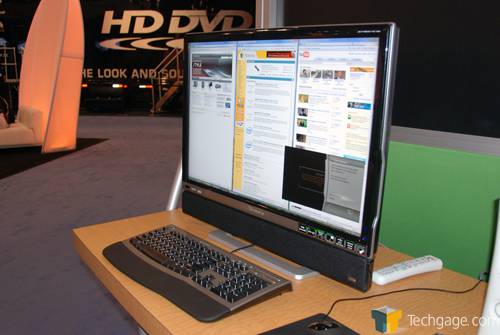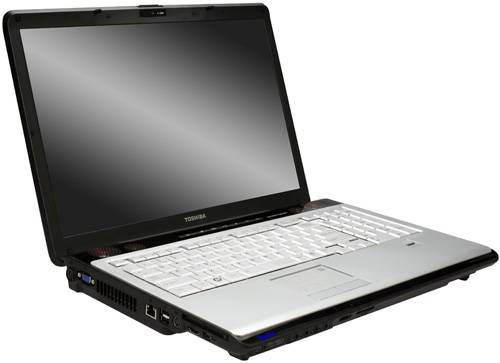- Qualcomm Launches Snapdragon 4 Gen 2 Mobile Platform
- AMD Launches Ryzen PRO 7000 Series Mobile & Desktop Platform
- Intel Launches Sleek Single-Slot Arc Pro A60 Workstation Graphics Card
- NVIDIA Announces Latest Ada Lovelace Additions: GeForce RTX 4060 Ti & RTX 4060
- Maxon Redshift With AMD Radeon GPU Rendering Support Now Available
DigitalLife 2007: On The Showfloor – Part 2

In our final portion of DigitalLife coverage, we take a look at Gateway’s new 30-inch monitor that you do want to see, Toshiba’s latest X205 SLI-configured notebook, ooma’s “free” VoIP solution, Gyration’s latest media remote and even more photos from around the show floor.
Page 1 – Introduction
|
|
In years past, Gateway’s products never really grabbed my attention. This year is certainly different. First, they launched a great-looking 24″ monitor that had picture-quality and a feature-set that surpassed the competition. Then they were aquired by Acer. Then they announced the Gateway One. However, as great as all of that is… the product that truly impressed me was their XHD3000 30″ Widescreen monitor.
The XHD3000 is a 30″ monitor that offers 2560×1600 resolution, usual fare. It offers support for 1600P video and every connector you will ever need: Single/Dual-Link DVI, VGA, Composite, Component, HDMI and even the classic S-Video. Unlike most other 30″ panels, this one offers a very bright 400 cd/m2 display, with a contrast ratio of 1000:1 and 6ms response time. Compared to the 30″ Dell HC monitor I’ve been using for the past two months, there is really no comparison when it comes to brightness and color vibrance.
The most impressive feature about the monitor though, is it’s upscaling capabilities. Equipped with a Silicon Optix Realta HQV video processor, any input run through the monitor can be upscaled to the screens native resolution. When I first passed by, an HD-DVD of Willy Wonka was playing and the quality was striking. I had first thought it was an actual TV until I looked closer.
To further show off upscaling abilities, a Gateway representative loaded up a copy of Bioshock, set the resolution to 1024×768 and loaded up a saved game. Now, clearly the ultra-low resolution is going to be noticeable when run full-screen, simply because things in the game will appear larger as is always the case. However, what was surprising was the fact that the game did not look that bad.. it was completely playable, despite the black bars on each side (due to differing aspect ratios).
The test that sold me though, was when Bioshock was set to 1920×1200 resolution and then run. The reason I was most interested in this setting is because I run an older MMORPG game at that same resolution on the Dell 30″ HC monitor, because the game engine was developed before the 30″ resolution existed and so it’s not supported. When set to 1920×1200 and “upscaled”, it looks horrible. Colors are faded, fonts are somewhat blotchy. It’s simply not a desirable setting… one that you would certainly not deliberately choose to use.
Bioshock however, looked simply incredible, despite being at a non-native resolution. In fact, I actually found it quite difficult to see any differences between the two resolutions. The thought popped into my head, “What about the in-game fonts and menus?”, but the rep loaded up the menu and I was surprised to see that all of the characters were just as aliased as though it was a native resolution. Again making it even more difficult to distinguish the fact that it was being run in a non-native resolution.
I might sound a bit excited about this product, but it’s for good reason. I walked away from Gateway’s booth with plans to purchase one of these become available. This after seeing just a five-minute demo… it’s that good. We will certainly be following up on all of these thoughts once we get our hands on one to experiment with in greater detail. Without question, if we had such a thing, Gateway’s XHD3000 would get our product of the show award. You can pick one up sometime in October for around $1,699, which includes 8-channel speakers.
Earlier this week, information was released about Toshiba’s new SLI gaming notebooks, the X205-SLi1 and X205-SLi3. We were lucky enough to test out the laptops at the show and I can say that I contemplated grabbing one and running to see how far I could make it.
The obvious selling feature of the notebook is the fact that two GeForce 8600M GT’s are installed in SLI mode, so the gaming experience should be just that much better. I’m unsure at this point what performance numbers you should expect, but we will have a copy of the notebook in within the next few weeks and will be able to deliver those at that time.
One thing that constantly drives me nuts about “gaming notebooks” is the fact that most of them overheat so quickly, your game will lag. This is silly, as you are likely to bring such a notebook to a LAN party and having a laggy system is only going to get you killed over and over. I questioned Toshiba about their cooling solution and asked if the game would ever prove laggy due to overheating. They simply told me no, and proved it by showing me the X205 on display.
This particular model was playing Bioshock, and hadn’t left the game for the entire day. Despite the fact that it was on for many hours, the game still ran very smooth, with no noticeable lag. Sadly, I am not sure what resolution was being used, but at quick glance, it didn’t strike me as being ugly. Similar to Dell’s XPS notebooks, Toshibas are built larger and with sufficient fans for efficient cooling.
Gaming might not be the only thing you want to do on a notebook though, which is why Toshiba includes extra goodies for additional entertainment needs, including an HD-DVD player on both of the SLI models. On the SLi1, you will have a screen resolution of 1440×900 while the SLi3 offers 1680×1050. The SLi3 also offers a slightly faster processor, bigger hard-drives, warranting a $500 increase in price, settling in at $2,499. The SLi1 model will retail for $1,999.
|
|
Support our efforts! With ad revenue at an all-time low for written websites, we're relying more than ever on reader support to help us continue putting so much effort into this type of content. You can support us by becoming a Patron, or by using our Amazon shopping affiliate links listed through our articles. Thanks for your support!







